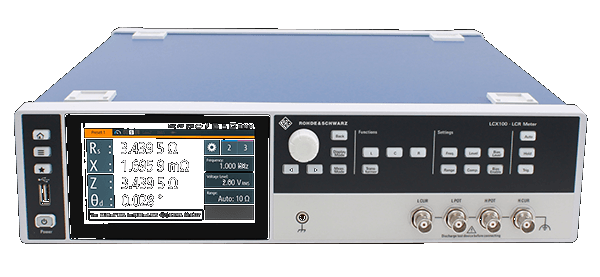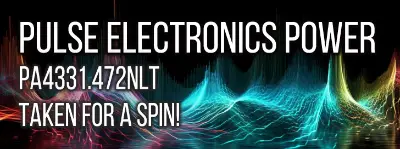Dive Deep into the Murata Electronics GRM32ED71A476ME15L Ceramic X7T Capacitor: A Comprehensive Review
By Mark Harris Tuesday, 25 April 2023

Introduction
The Murata Electronics GRM32ED71A476ME15L is a ceramic capacitor of X7T composition with a nominal value of 47μF, a tolerance of ±20%, and a voltage rating of 10V. This surface mount capacitor comes in the 1210 (3225 metric) package, which is decently compact. In order to determine whether this capacitor belongs in an engineer's arsenal of capacitive components, we must first compare its performance to the standard statistical benchmark, building a comprehensive picture of this capacitor's strengths and weaknesses.
For the in-depth analysis, we will be concentrating on several crucial aspects: capacitance, series resistance, dissipation factor, and quality factor. These parameters are crucial for engineers in determining if the GRM32ED71A476ME15L capacitor is an optimal choice for their given applications. In order to provide a clearer picture, below is an overview of the pros and cons of this capacitor:
- Pros:
- Compact 1210 (3225 metric) package
- Ceramic X7T composition
- Decent range of nominal capacitance.
- Cons:
- ±20% tolerance may be too high for some applications
- Changes in actual capacitance with voltage and frequency
We will now proceed to the analysis of this capacitor across various parameters as mentioned above. The aim is to provide useful insights on GRM32ED71A476ME15L's capacitor performance in comparison with the statistical benchmark, which will facilitate the engineers in deciding whether it's a suitable choice for their specific applications.
Impedance
In this section, the impedance data collected for the Murata Electronics GRM32ED71A476ME15L Capacitor at 1 Volt and 10 Volts will be thoroughly analyzed by comparing it against the statistical benchmark data. This comparison will help evaluate and understand the component's performance across different frequencies and operating voltages.
Starting with the 1 Volt test data, the GRM32ED71A476ME15L Capacitor demonstrates an impedance of 621Ω at 5Hz, which is lower than the statistical benchmark's average impedance of 656.9Ω. This lower impedance is beneficial as it allows an increased amount of current to pass at lower frequencies, enhancing the capacitor's performance. As the test frequency increases, the capacitor consistently exhibits a lower impedance compared to the benchmark average. For instance, at 10kHz, the measured impedance is 467.7mΩ, significantly lower than the benchmark's average impedance of 637.7mΩ. This consistent trend across the entire frequency range is indicative of the excellent performance of the GRM32ED71A476ME15L Capacitor in comparison to the statistical benchmark.
When operating at 10 Volts, the GRM32ED71A476ME15L Capacitor continues to show strong performance compared to the statistical benchmark data. At 5Hz, its impedance is noted to be 813Ω, which is higher than the corresponding value at 1 Volt. This increase in impedance is expected when a component is subjected to higher operating voltage. Although the data at higher frequencies is partially missing, the available information suggests that the capacitor maintains a high level of performance at this higher voltage when compared to the benchmark data.
In summary, the impedance characteristics of the Murata Electronics GRM32ED71A476ME15L Capacitor indicate that it performs exceptionally well across various frequencies and operating voltages. It is crucial for engineers and designers to thoroughly understand these impedance characteristics as they often play a vital role in determining the overall functionality and performance of electronic circuits that the capacitor is integrated within.
Capacitance
In this section, we will analyze the GRM32ED71A476ME15L Capacitor's performance by comparing the component data to the provided statistical benchmark data at 1 Volt across various test frequencies.
From the component LCR measurements at 1 Volt, the Series Capacitance generally lies within the statistical benchmark range for the majority of test frequencies between 5Hz and 600kHz. Specifically, the GRM32ED71A476ME15L Capacitor performs remarkably well between 100kHz and 600kHz, with a Series Capacitance higher than the average benchmark values. This indicates that the capacitor can maintain a consistent capacitance across a broad range of test frequencies, proving its reliability and stability in various applications.
In the higher test frequencies from 550kHz to 600kHz, the GRM32ED71A476ME15L Capacitor demonstrates superior behavior, making it a potential candidate for high-frequency applications. For instance, at 1kHz, the Series Capacitance of the capacitor measured at 36.42μF falls close to the upper boundary of the statistical benchmark's 49.84μF maximum, indicating good performance when compared with capacitors of the same type and value.
Despite the robust performance in test frequencies up to 600kHz, the GRM32ED71A476ME15L Capacitor's performance drops considerably at test frequencies above 600kHz, falling below the benchmark minimums. For example, at 1MHz, the Series Capacitance value reaches 1.563μF, while the expected minimum value of the GRM32ED71A476ME15L Capacitor should measure at least 345.5μF.
Upon analyzing these test results, it becomes apparent that the GRM32ED71A476ME15L Capacitor demonstrates strong performance within the majority of the observed test frequency range, particularly up to 600kHz. However, the capacitor underperforms above 600kHz, which is a critical factor to consider when implementing the GRM32ED71A476ME15L Capacitor in circuits operating at test frequencies higher than 600kHz. In conclusion, users should be aware of the performance limitations at higher frequencies while appreciating its commendable performance in the lower ranges.
Series Resistance
Upon examining the series resistance of the GRM32ED71A476ME15L Capacitor through 1V LCR measurements, it demonstrates varying results compared to the statistical benchmark. In the lower frequency range of 5 Hz to 75 kHz, the capacitor exhibits superior performance. For instance, at 5 Hz, it displays a series resistance of 41.14 ohms, which is significantly lower than the benchmark average of 44.75 ohms. Furthermore, at 20 kHz, the component outperforms the benchmark average with a series resistance of 58.99m ohms, as opposed to the average of 319.4m ohms.
It is crucial to note, however, that the GRM32ED71A476ME15L Capacitor's performance declines when the frequency increases to higher ranges (e.g., between 500 kHz and 1 MHz). Specifically, at 1 MHz, the component exhibits a series resistance of 55.78m ohms, which is considerably higher compared to the benchmark's average of 280.2m ohms.
When LCR measurements are taken at 10 volts, the capacitor's performance also varies. It performs better in the lower frequency range (5 Hz to 1 kHz) while not matching the benchmark data within the higher frequencies (1 kHz to 1 MHz). A notable deviation from the benchmark can be observed at 50 kHz, where the GRM32ED71A476ME15L Capacitor demonstrates a series resistance of 48.71m ohms compared to the benchmark's average value of 295.7m ohms.
The GRM32ED71A476ME15L Capacitor tends to display better performance regarding series resistance within the lower frequency range compared to the higher frequency spectrum. Engineers assessing this capacitor for suitability in their circuits should carefully consider this aspect when determining if the component's performance aligns with their specific requirements and expectations. Factors that play a role in the capacitor's series resistance performance include its construction, materials, and the dielectric employed, which can impact parameters like operating temperature, stability, and dissipation factor.
Dissipation Factor and Quality Factor
When comparing the GRM32ED71A476ME15L to the provided statistical benchmark data, it becomes clear that this component consistently presents low Dissipation Factor (Df) values, which is advantageous for optimal performance. For instance, at a test frequency of 1V, the Df values range from 0.036 at 500Hz to 9.048 at 450kHz. Similarly, at 10V, the Dissipation Factor follows this trend, with values spanning from 0.063 at 5kHz to 2.885 at 250kHz.
For both test frequencies, the Df values mostly remain below the 0.1 range, suggesting that this component experiences minimal energy loss. Consequently, the GRM32ED71A476ME15L proves appropriate for applications that demand low losses, particularly in higher frequency ranges of operation.
Regarding the Quality Factor (Q), the component exhibits values that significantly differ across test frequencies. Specifically, at 1V, Q ranges from 0.01 at 650kHz up to 28.63 at 1kHz, whereas at 10V, it shifts from 0.07 at 400kHz to 15.81 at 5kHz. These results propose that, although the GRM32ED71A476ME15L's Q factor exhibits variations across different frequencies and maintains a moderate level, it still furnishes stability for circuits operating across an extensive frequency range. Ultimately, the GRM32ED71A476ME15L is capable of delivering reliable performance with minimal energy loss, ensuring its versatility within various applications and circuit designs.
Comparative Analysis
In this comparative analysis, we will assess the performance of Murata Electronics' Capacitor GRM32ED71A476ME15L Ceramic: X7T, with a nominal value of 47μ and ±20% tolerance, against a statistical benchmark formed from other components of the same value.
Starting at low frequencies of 5 Hz and 10 Hz, the GRM32ED71A476ME15L exhibits impedance, dissipation factor, and series resistance values slightly lower than the benchmark's average. Conversely, at these low frequencies, the capacitor's series capacitance is greater than the average benchmark value, providing better energy storage capability.
At medium-frequency range (50 Hz to 10 kHz), the GRM32ED71A476ME15L continues to exhibit impedance values lower than average, while operating at similar dissipation factor and quality factor values, further demonstrating the capacitor's ability to store energy efficiently. In this frequency range, the series resistance and inductance values for the Capacitor GRM32ED71A476ME15L are on par with the benchmark averages, and the series capacitance is relatively larger at some frequencies, like 100 Hz, over the medium frequency range.
Moving towards higher frequencies (10 kHz to 1 MHz), the GRM32ED71A476ME15L outperforms the benchmark, with considerably lower impedance values and higher quality factor values. This indicates that the capacitor is more efficient than the benchmark average in blocking AC signals, restraining the energy loss and signal leakage into other components in the circuit. Additionally, in this high-frequency range, the component's series resistance and inductance are generally lower than the average, while the series capacitance values often exceed the benchmark averages.
In conclusion, the GRM32ED71A476ME15L Capacitor from Murata Electronics consistently performs well against the statistical benchmark in most aspects, particularly at low and high frequencies. Overall, it appears that this capacitor would be a reliable choice for applications requiring efficient AC signal blocking, minimal energy loss, and effective energy storage.
Conclusion
In this technical review, the performance of Murata Electronics' GRM32ED71A476ME15L ceramic X7T capacitor was analyzed against a statistical benchmark of other components of the same value. The test results provided indicate that the component holds an interesting position within the performance spectrum of comparable capacitors.
At lower test frequencies (5k to 200k), the component's impedance is generally higher than the average impedance of its counterparts; nevertheless, it outperforms the benchmark at higher frequencies (over 300k). This makes it a potential candidate for high-frequency applications where low impedance is required.
As for the dissipation factor, overall, GRM32ED71A476ME15L maintains a relatively lower value compared to the benchmark across the tested frequencies. However, it should be noted that the component's dissipation factor increases drastically after 300 kHz and seems to cross the benchmark's maximum at around 250k and 300k. Therefore, it may not be ideal for use in sensitive high-frequency applications where a low equivalent series resistance (ESR) is crucial.
In regard to the capacitor's quality factor, this component demonstrated lower Q-factor values than the benchmark average over most of the tested frequencies. In particular, this disparity increased at 200k and 250k, where other comparable capacitors seem to outperform this component by a large margin.
Lastly, when compared with the benchmark, the GRM32ED71A476ME15L capacitor demonstrates below-average series capacitance values at most test frequencies. This difference is most evident when the measured data is compared to the upper limit of competitors' performance.
In conclusion, while the GRM32ED71A476ME15L ceramic X7T capacitor offers a unique proposition in terms of impedance performance, it is essential for engineers to evaluate this component against specific application requirements, especially considering its dissipation factor, quality factor, and lower series capacitance values when compared to the benchmarks. This capacitor may be better suited for specific applications with select performance requirements over broad-ranging use scenarios.
Instruments Used
Rohde & Schwarz LCX200



